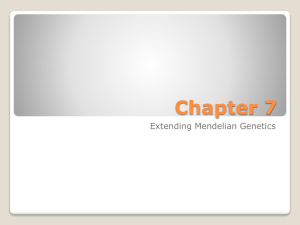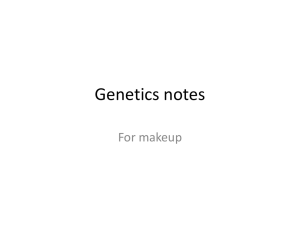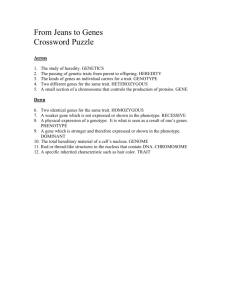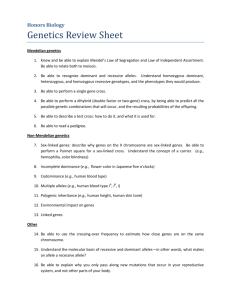Nonmendelian Genetics
advertisement
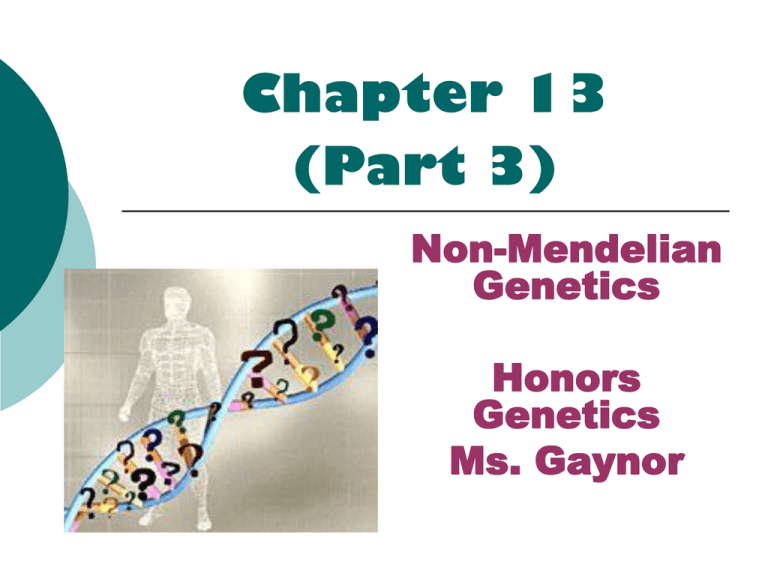
Chapter 13 (Part 3) Non-Mendelian Genetics Honors Genetics Ms. Gaynor Extending Mendelian Genetics for a Single Gene The inheritance of characters by a single gene May deviate (do NOT follow) from simple Mendelian patterns Examples Incomplete dominance, codominance, multiple alleles, pleiotropy The Spectrum of Dominance Complete dominance Occurs when the phenotypes of the heterozygote (Hh) and dominant homozygote (HH) are identical Demonstrates or follows “Mendelian Genetics” inheritance pattern “Non-Mendelian Genetics” Incomplete (intermediate) Dominance 1 allele is not completely dominant over the other, so heterozygote (Hh) has intermediate (or mixed) phenotype between 2 alleles (like snapdragon flowers) P Generation White CWCW Red CRCR CR Gametes CW Pink CRCW F1 Generation 1⁄ 2 Gametes Eggs 1⁄ 2 CR CR 1⁄ 2 CR 1⁄ 2 CR F2 Generation 1⁄ 2 Figure 14.10 1⁄ 2 CR CR CR CR CW CR CW CW CW Cw Sperm Let’s do some practice problems… Assume incomplete dominance… A red gummy bear mates with a yellow gummy bear. Red (R) is dominant. What are the genotype/phenotype ratios of their F1 offspring? 100% Rr 100% orange If 2 F1 gummy bears from the question above mate. What are the genotype/phenotype ratios of their F2 offspring? 25% RR 50% Rr 25% rr 25% Red 50% orange 25% yellow “Non-Mendelian Genetics” Codominance 2 dominant alleles affect phenotype in separate, distinguishable ways BOTH phenotypes are present Ex’s of codominance Some flowers and Roan animals (cattle & horses) Roan Animals Show Codominance Let’s do some practice problems… Assume codominance… A blue flower mates with a yellow flower. Blue (B) is dominant. What are the genotype/phenotype ratios of their F1 offspring? BB= blue Bb= blue & yellow bb= yellow 100% Bb 100% Blue AND yellow flowers If 2 F1 flowers from the question above mate. What are the genotype/phenotype ratios of their F2 offspring? 25% BB 25% Blue 50% Bb 50% blue AND yellow 25% bb 25% yellow Multiple Alleles A type of codominance Most genes exist in populations In more than two allelic forms that influence gene’s phenotype Ex: Human Blood type The ABO blood group in humans Is determined by multiple alleles Multiple Alleles (Codominance) Blood Type Genotypes A AB IAIA, or I Ai IBIB, or I Bi I AI B O ii B Blood Type Practice A woman with Type O blood and a man, who is Type AB, are expecting a child. What are the possible blood types of their child? ii x IAIB 50% chance IAi (A type); 50% chance IBi (B type) What are the possible blood types of a child who's parents are both heterozygous for "B" blood type? IBi X IBi 50% chance IBi, 25% chance IBIB, 25% chance ii • 75% chance of B type and 25% chance of O type More Blood Type Practice What are the chances of a woman with Type AB and a man with Type A having a child with Type O? IA? x IAIB 0% chance of Type O b/c mom can’t donate “i” allele Jill is blood Type O. She has two older brothers with blood types & B. What are the genotypes of her parents? IAi and IBi Jerry Springer did a test to determine the biological father of child The child's blood Type is A and the mother's is B. Daddy Drama #1 has a blood type of O & Daddy Drama #2 has blood type AB. Which man is the biological father? Dad #1 = ii and Dad #2= IAIB It has to be Daddy #2 Polygenic Inheritance Many genes (2+) determine one (1) phenotype Many human traits Vary in the population along a continuum Few genes actually follow a simple Mendelian inheritance pattern Examples: Height, eye color, intelligence, body build and skin color Polygenic Inheritance AaBbCc aabbcc 20⁄ 15⁄ 64 64 6⁄ 64 1⁄ 64 Aabbcc AaBbcc AaBbCc AaBbCc AABbCc AABBCc AABBCC Nature and Nurture: The Environmental Impact on Phenotype Departs from simple Mendelian genetics phenotype depends on environment as well as on genotype Called multifactorial inheritance Ex: human fingerprints hydrangea flowers Al in soil; need LOW pH Add P to soil; need HIGHERpH Chapter 11 (Part 4) Human Genetics Honors Genetics Ms. Gaynor Many human traits follow Mendelian patterns of inheritance Humans are not convenient subjects for genetic research However, the study of human genetics continues to advance We use pedigrees! Pedigree Analysis pedigree Is a family tree that describes the interrelationships of parents and children across generations A Inheritance patterns of particular traits can be traced and described using pedigrees Ww ww Ww ww ww Ww WW or Ww ww Ww First generation (grandparents) Ww ww Second generation (parents plus aunts and uncles) FF or Ff Ff Ff Third generation (two sisters) ww Widow’s peak Ff No Widow’s peak Attached earlobe ff ff Ff Ff Ff ff ff FF or Ff Free earlobe Figure 14.14 A, B (a) Dominant trait (widow’s peak) (b) Recessive trait (attached earlobe) Pedigrees Can also be used to make predictions about future offspring Recessively Inherited Disorders Many genetic disorders are inherited in recessive manner Show up only in individuals homozygous for the alleles Carriers Are heterozygous individuals, who carry recessive allele but are show “normal” phenotype Cystic Fibrosis Example of recessive disorder Affect mostly people of European descent Symptoms Mucus buildup in the some internal organs Abnormal absorption of nutrients in the small intestine Sickle-Cell Disease Another recessive disorder Affects one out of 400 African-Americans Is caused by the substitution of a single amino acid in the hemoglobin protein in red blood cells Symptoms Physical weakness, pain, organ damage, and even paralysis Dominantly Inherited Disorders Some human disorders Are due to dominant alleles Example is achondroplasia Form of dwarfism lethal when homozygous for the dominant allele Another Dominant Disorder Huntington’s disease (HD) degenerative disease of nervous system No obvious phenotypic effects until about 35 to 40 years of age HD Normal Down Syndrome Down syndrome Is usually the result of an extra chromosome 21 trisomy 21 Genetic Testing and Counseling Genetic counselors Can provide information to prospective parents concerned about a family history for a specific disease Tests for Identifying Carriers For a growing number of diseases Tests are available that identify carriers and help define the odds more accurately Examples Tay Sachs & CF Fetal Testing In amniocentesis The liquid that bathes fetus is removed & tested In chorionic villus sampling (CVS) A sample of the placenta is removed and tested Can make karyotypes, too! Newborn Screening Some genetic disorders can be detected at birth Simple tests are now routinely performed in most hospitals in the United States Example- PKU test Chapter 13 (PART 5) The Chromosomal Basis of Inheritance Introduction to Sex Linkage Honors Genetics Ms. Gaynor Gene Linkage Linked genes Usually inherited together because located near each other on the SAME chromosome Genes closer together on the same chromosome are more often inherited together Each chromosome Has 100’s or 1000’s of genes Sex-linked genes exhibit unique patterns of inheritance; genes on the X or Y chromosome Morgan’s Experimental Evidence Thomas Hunt Morgan Provided convincing evidence that chromosomes are the location of Mendel’s heritable alleles Sex linkage explained http://nobelprize.org/nobel_prizes/medicine/articles/lewis/index.html Thomas Hunt Morgan (Columbia University 1910) Fruit Flies (Drosophila) melanogaster) © 2007 Paul Billiet ODWS Morgan’s Choice of Experimental Organism Morgan worked with fruit flies Lots of offspring A new generation can be bred every two weeks They have only 5 pairs of chromosomes Morgan and Fruit Flies Morgan first observed and noted Wild type (most common) phenotypes that were common in the fly populations Traits alternative to the wild type are called mutant phenotypes w+ WILDTYPE w MUTANT The case of the whiteeyed mutant Character Eye color type) Traits Red eye (wild White eye (mutant) P Phenotypes Wild type (red-eyed) female x White-eyed male F1 Phenotypes All red-eyed Red eye is dominant to white eye Hypothesis A cross between the F1 flies should give us: 3 red eye : 1 white eye F2 Phenotypes Numbers So far so good Red eye White eye 3470 82% 782 18% An interesting observation The F2 generation showed the 3:1 red: white eye ratio, but only males had white eyes Phenotypes F2 Numbers Redeyed males Redeyed females Whiteeyed males Whiteeyed 1011 2459 782 0 24% 58% 18% 0% females A reciprocal cross Morgan tried the cross the other way round white-eyed female x red-eyed male Result All red-eyed females and all whiteeyed males This confirmed what Morgan suspected The gene for eye color is linked to the Morgan’s Discovery: Sex Linked Traits Eye color is linked on X Chromosome Females carry 2 copies of gene; males have only 1 copy If mutant allele is recessive, white eyed female has the trait on both X’s White eyed male can not hide the trait since he has only one X. The Chromosomal Basis of Sex An organism’s sex Is an inherited phenotype determined by the presence or absence of certain chromosomes XX = girl XY = boy Inheritance of SexLinked Genes sex chromosomes Have genes for many characters unrelated to sex (especially the X chromosome) A gene located on either sex chromosome Is called a sex-linked gene The (Usually on X chromosome) What genes are on the X chromosome? carries a couple thousand genes but few, if any, of these have anything to do directly with sex determination Larger and more active than Y chromosome What genes are on the Y chromosome? Gene called SRY triggers testis development, which determines male sex characteristics This gene is turned “on” ~6 weeks into the development of a male embryo Y-Chromosome-linked diseases are rare Sex-linked genes follow specific patterns of inheritance Fathers pass sex-linked alleles to ALL their daughters but NONE to their sons XY (Father) XX (daughter) XY (Father) XY (son) Mothers can pass sex-linked alleles to BOTH sons and daughters XX (Mother) XX (daughter) XX (Mother) XY (son) Sex Linkage If sex-linked recessive on Xn Females have to be Xn Xn to show sex-linked trait Xn X Females do NOT show sexlinked trait Males have to be Xn Y to show sexlinked trait **Most sex-linked disorders affect males; sometimes females Sex-Linked Disorders Some recessive alleles found on the X chromosome in humans cause certain types of disorders Color blindness Duchenne muscular dystrophy Hemophilia Male pattern baldness X-Linked Trait = Male Pattern Baldness Baldness Another X-Linked Trait = Hemophilia About 85% of hemophiliacs suffer from classic hemophilia 1 male in 10 000 cannot produce factor VIII The rest show Christmas disease where they can’t make factor IX The genes for both forms of hemophilia are sex linked Hemophiliacs have trouble clotting their blood Another X-Linked Trait = Red-Green Colorblindness Normal vision Color blind simulation http://www.onset.unsw.edu.au/issue1/colourblindness/colourblindness_print.htm Another X-Linked Trait = Duchenne Muscular Dystrophy


